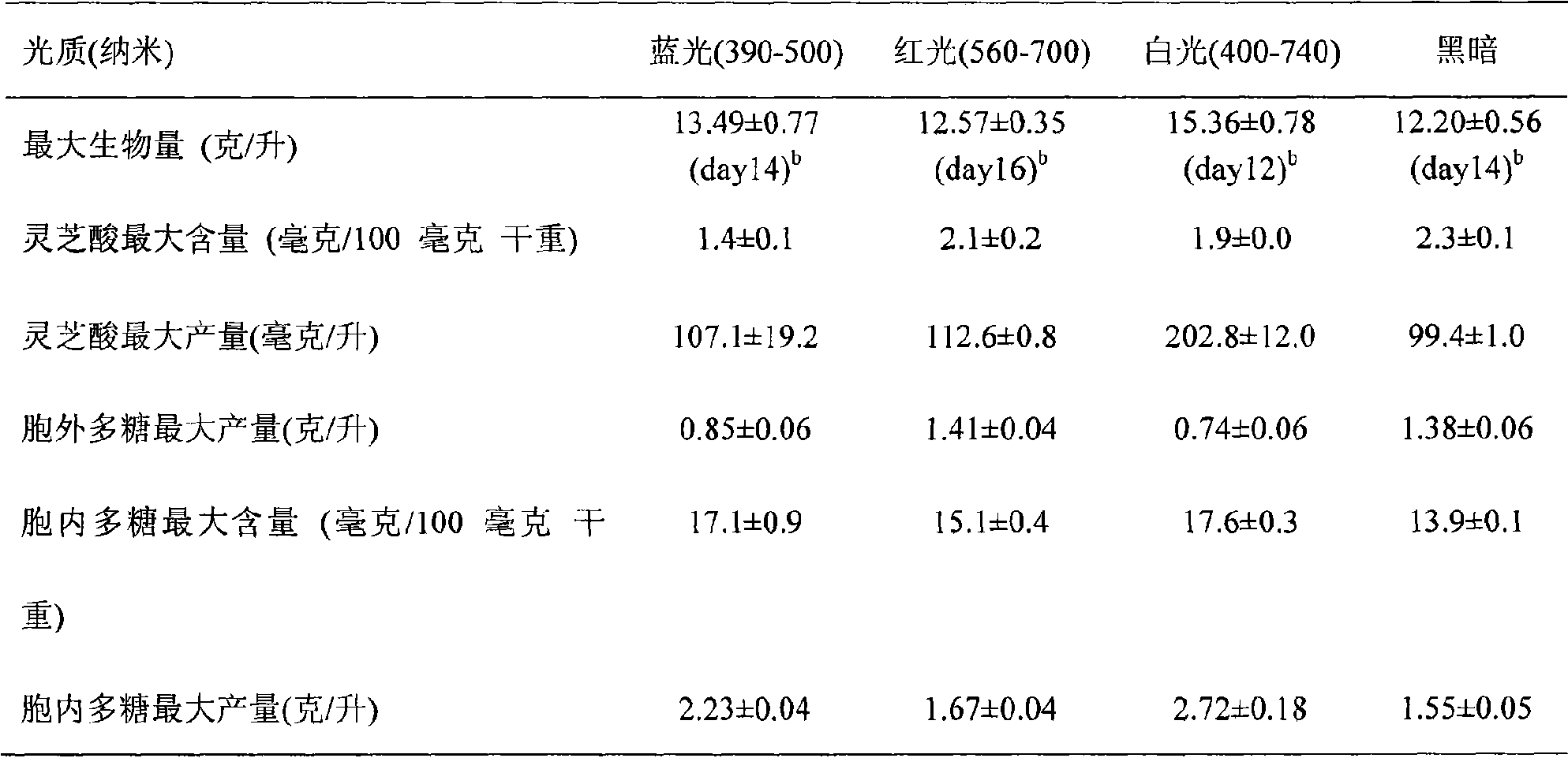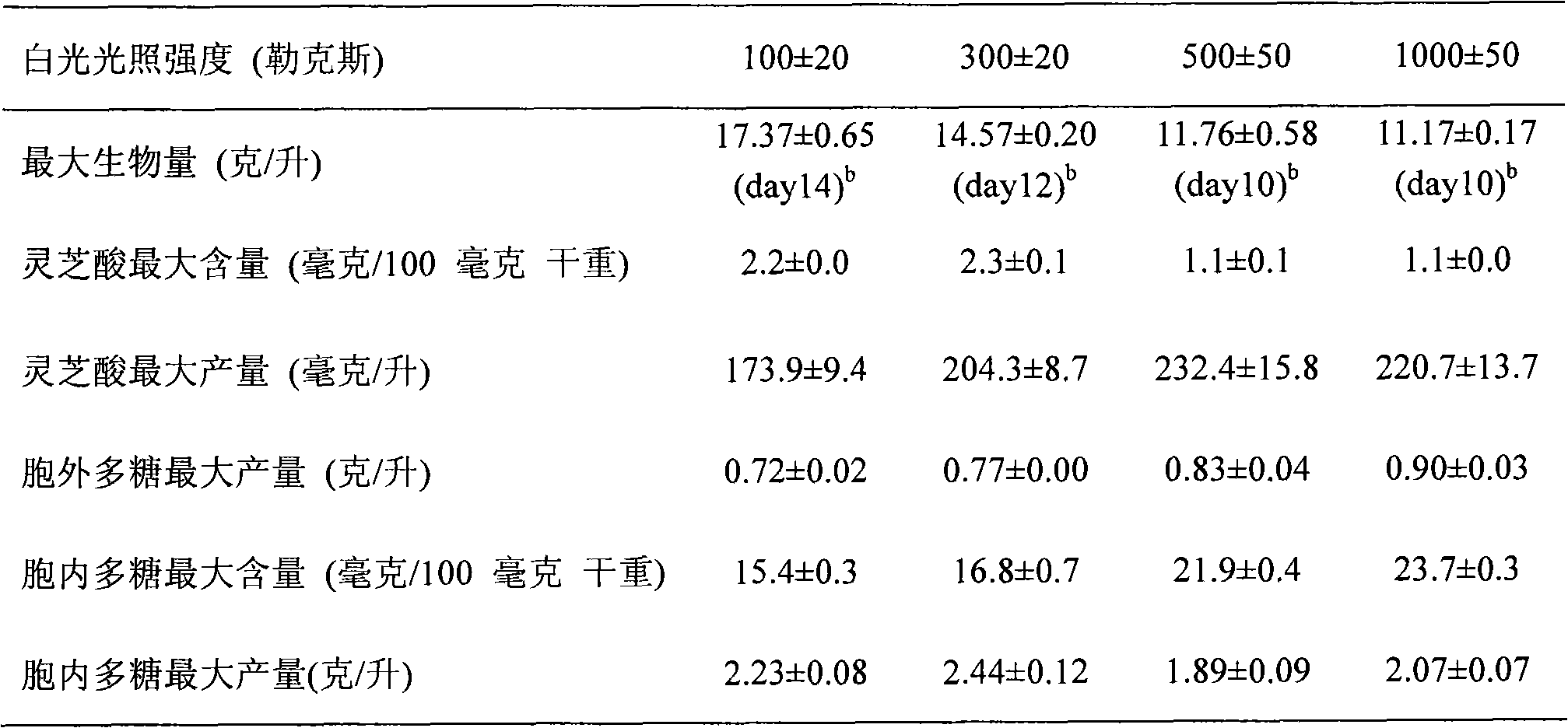Glossy ganoderma cell culture method for accelerating biosynthesis of ganoderic acid and ganoderma iucidum polysaccharide
A cell culture, Ganoderma lucidum polysaccharide technology, applied in the field of microbial fermentation, can solve the problems of unseen light cell growth, the physiological and biochemical effects of product synthesis cells, etc.
- Summary
- Abstract
- Description
- Claims
- Application Information
AI Technical Summary
Problems solved by technology
Method used
Image
Examples
Embodiment 1
[0031] According to the following culture medium and culture conditions, the culture of ganoderma lucidum slant strains, first-level liquid seed culture, second-level liquid seed culture and liquid submerged fermentation were carried out:
[0032] Described slant culture medium is PDA agar medium (magnesium sulfate heptahydrate of 1.5 grams / liter, potassium dihydrogen phosphate of 3.0 grams / liter, glucose of 20 grams / liter, vitamin B2 of 0.05 grams / liter 1 and 200 g of potatoes / liter of extract). The cultivation conditions of the ganoderma lucidum slant strains are: cultivation temperature 28° C., dark cultivation, and cultivation time 7 days.
[0033] The first-level liquid seed culture medium is: 35 grams / liter of glucose, 5 grams / liter of peptone, 2.5 grams / liter of yeast powder, 0.5 grams / liter of magnesium sulfate heptahydrate, 1 gram / liter of potassium dihydrogen phosphate, vitamin B 1 0.05 g / l. Primary liquid seed culture conditions: temperature 30°C, rotary shaker, r...
Embodiment 2
[0044] This test has carried out 4 groups of parallel Ganoderma lucidum cell culture experiments, and the culture medium and culture condition of each group are all the same as embodiment 1, the difference is: in the liquid submerged fermentation, each group adopts light intensity respectively to be 100 ± 20 lux, 300 lux. ± 20 lux, 500 ± 50 lux, 1000 ± 50 lux white light for light culture; the cells were weighed after drying at 60 ° C, and the dried cells were determined according to Tang and Zhong (Enzyme Microb. Technol. 2002, 31: 20-28 ) method, the contents of Ganoderma lucidum polysaccharide and Ganoderma acid were determined by concentrated sulfuric acid-phenol method and ultraviolet spectrophotometry respectively. The test results are shown in Table 3.
[0045] Table 3 Effects of white light with different light intensities on content and yield of ganoderma acid and ganoderma polysaccharide
[0046]
[0047] a All values are the mean of three values plus standar...
Embodiment 3
[0051] This test is carried out on the basis of embodiment 1 and embodiment 2. Be divided into test group and control group, control group is dark cultivation in liquid submerged fermentation process, and other conditions are the same as test group (the culture condition of culture medium and each stage is the same as embodiment 1); Test group is divided into 3 parallel groups, the first The first stage adopts dark cultivation, and the second stage adopts white light with a light intensity of 500 lux for light cultivation. The time points from the first stage to the second stage are respectively the 2nd day, the 4th day and the 6th day when the submerged fermentation starts sky. The cells were weighed after drying at 60°C, and the dried cells were extracted and treated according to the method of Tang and Zhong (Enzyme Microb. Technol. 2002, 31: 20-28), and then the concentrated sulfuric acid-phenol method and UV spectrophotometry were used respectively. The contents of Ganode...
PUM
| Property | Measurement | Unit |
|---|---|---|
| wavelength | aaaaa | aaaaa |
| wavelength | aaaaa | aaaaa |
Abstract
Description
Claims
Application Information
 Login to View More
Login to View More - R&D
- Intellectual Property
- Life Sciences
- Materials
- Tech Scout
- Unparalleled Data Quality
- Higher Quality Content
- 60% Fewer Hallucinations
Browse by: Latest US Patents, China's latest patents, Technical Efficacy Thesaurus, Application Domain, Technology Topic, Popular Technical Reports.
© 2025 PatSnap. All rights reserved.Legal|Privacy policy|Modern Slavery Act Transparency Statement|Sitemap|About US| Contact US: help@patsnap.com



